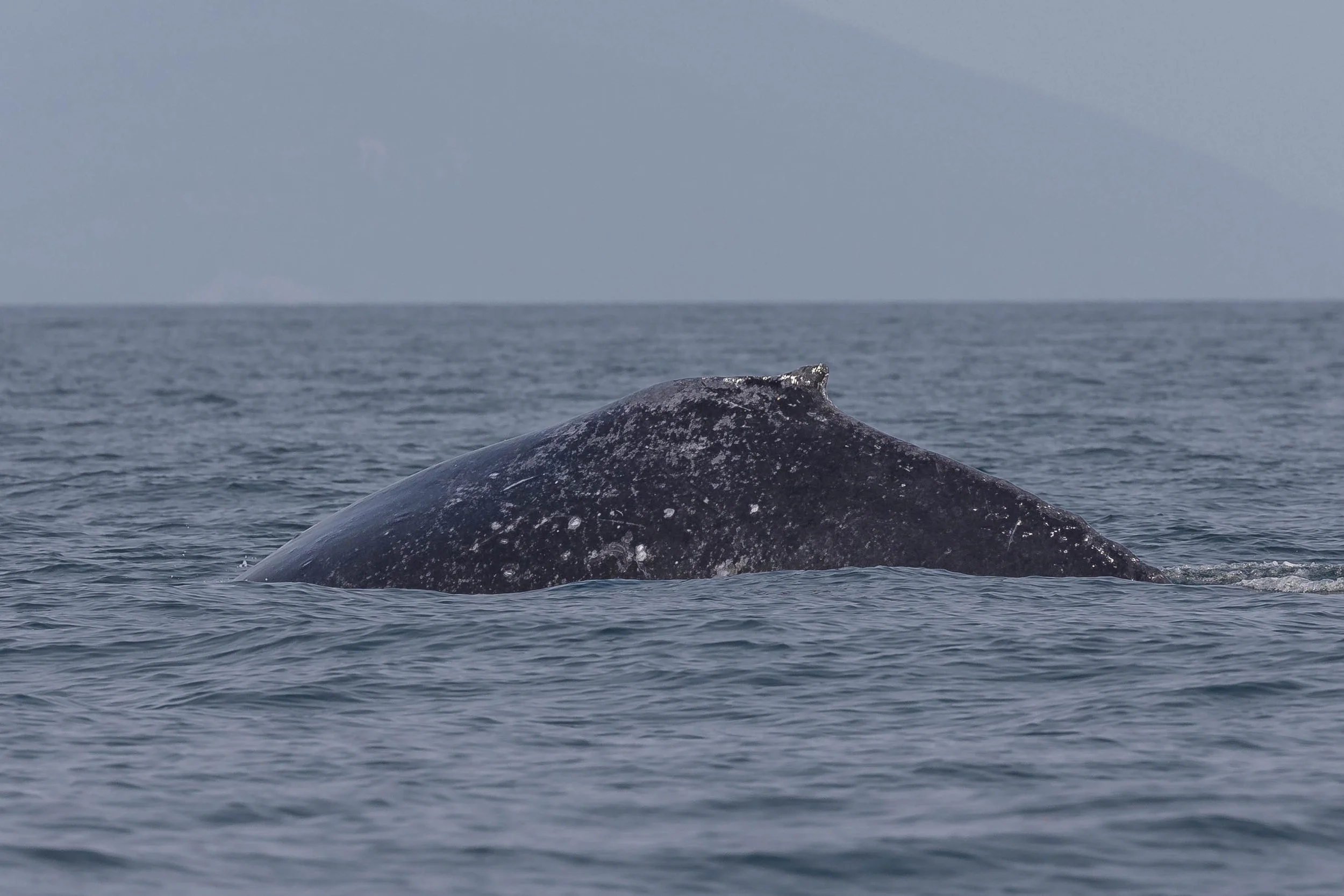August 8, 2024, 3:30 pm - Some fun from Wisp and plenty of others!
It was a beautiful calm afternoon as all three of our boats left the harbour again. We had success in the morning, but even though whales can disappear in a matter of seconds from where they were originally, we were confident we could go out and find them again. It wasn’t too long before a boat came across their first Humpback Whale. When we leave the dock, we don’t send all the boats in one line, One might travel closer to the Gabriola shoreline, while the other is a few kilometres out into the Strait of Georgia, and one might head down through the Gulf Islands and out the first passage between islands. This is why our boats sometimes see different whales.
That boat was our zodiac Keta, and their whale was Kappa (BCX0158). Kappa is one of the older whales here in the Salish Sea, so she’s always a treat to see. Kappa has been coming back to our waters every summer for a couple of decades now, but officially has been seen with only one calf; in 2022. So we know she’s a female, but she could have calves that we don’t know about! If researchers did DNA studies, would we find a whale that belonged to Kappa? Food for thought.
Our other zodiac Cascadia, and our sei-covered boat Kula found Zephyr (BCZ0414) and her new calf! Zephyr is the grandchild of the most famous whale in the Salish Sea: BCY0324 Big Mama. Big Mama is famous because she was the first whale to come back into the Salish Sea after extensive whaling. In the 1860s, people here in BC started hunting humpback whales, along with other species of baleen whales, extensively. Between then and 1967, 14,000 humpback whales were taken out of British Columbia waters, 10,000 of which were caught by Coal Harbor in Vancouver. In 1967, Humpback Whales were protected under the International Whaling Commission, but by then there were next to no humpbacks visible in this area. In 1997, the first humpback whale was seen by photographer and captain Mark Malleson. This whale was Big Mama. She has since brought seven calves into our area, six of which are still alive. Big Mama’s first calf was Divot (BCX1057) in 2003, and Zephyr is Divot’s 2011 calf. Zephyr has since made Big Mama a Great-Grandmother! We look forward to many years of watching Big Mama and her descendants.
Eventually, all of our boats made their way over to watch Wisp (KEY0051). Wisp is a pretty young whale, so they are a little mischievous. Today, Wisp was curious about the boat, circling and poking their nose out of the water. It’s important to keep in mind that while getting close encounters with whales is fun, we never ever force them to interact, it will always be their decision if they get closer than the 100-meter regulation. Wisp kept up this behavior for around half an hour before they decided to go have fun by themselves. They came fully out of the water in a breach, which is always fun to see from a humpback!
All too soon, it was time to make our way towards home, but we kept an eye out for blows. When we’re coming to the end of our tour and we see a humpback on the way, we stop and get IDs before continuing on our way. Today, our zodiac Cascadia was able to quickly hang out with Graze (BCY0523) and Mantis (BCX0936). Graze is known to not be much of a fluker, so it was such a treat for us to see her flukes! We got our photos and continued on our way.
We made a quick pit stop at Stinky Rocks before we got home. Here, we can find Steller Sea Lions, Harbour Seals, and with some luck, Bald Eagles and Cormorants! We were fortunate enough to find all four today. We are also able to find a young seagull and their parent.
All too soon, we were back at the docks, but not without a successful day under or belt! Photos from today were taken by Marine Naturalists Aly Kohlman, Hayleigh Hilbert, and Val Watson.
Kappa’s fluke. Photo by Hayleigh Hilbert.
Kappa’s dorsal. Photo by Hayleigh Hilbert.
Kappa. Photo by Hayleigh Hilbert.
Wisp. Photo by Hayleigh Hilbert.
Graze (left) and Mantis (right). Photo by Val Watson.
Mantis fluking beside Graze. Photo by Val Watson.
Graze’s fluke. Photo by Val Watson.
Wisp’s face. Photo by Val Watson.
Wisp’s dorsal. Photo by Val Watson.
Wisp. Photo by Val Watson.
Zephyr’s 2024 calf. Photo by Aly Kohlman.
Photo by Aly Kohlman.
Photo by Aly Kohlman.
Breach for the sky! Photo by Aly Kohlman.
Wisp’s fluke. Photo by Aly Kohlman.
Look at that perfect pec fin! Photo by Aly Kohlman.
Cruising along. Photo by Aly Kohlman.
Wisp’s dorsal. Photo by Aly Kohlman.
Up close look at Wisp. Photo by Aly Kohlman.
A Bald Eagle perched on the rocks. Photo by Hayleigh Hilbert.
A Bald Eagle in flight. Photo by Hayleigh Hilbert.
A nursing Harbour seal pup. Photo by Hayleigh Hilbert.
Cuddle time! Photo by Val Watson.
Someone looks grumpy! Photo by Val Watson.
Cormorants sunning themselves. Photo by Aly Kohlman.
A Gull with a chick. Photo by Val Watson.


























